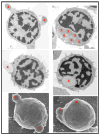Evolutionary and functional relationships of B cells from fish and mammals: insights into their novel roles in phagocytosis and presentation of particulate antigen
- PMID: 22394174
- PMCID: PMC3420344
- DOI: 10.2174/187152612800564419
Evolutionary and functional relationships of B cells from fish and mammals: insights into their novel roles in phagocytosis and presentation of particulate antigen
Abstract
The evolutionary origins of Ig-producing B cells appear to be linked to the emergence of fish in this planet. There are three major classes of living fish species, which from most primitive to modern they are referred to as agnathan (e.g., lampreys), Chondrichthyes (e.g., sharks), and teleost fish (e.g., rainbow trout). Agnathans do not have immunoglobulin- producing B cells, however these fish contain a subset of lymphocytes-like cells producing type B variable lymphocyte receptors (VLRBs) that appear to act as functional analogs of immunoglobulins. Chondrichthyes fish represent the most primitive living species containing bona-fide immunoglobulin-producing B cells. Their B cells are known to secrete three types of antibodies, IgM, IgW and IgNAR. Teleost fish are also called bony fish since they represent the most ancient living species containing true bones. Teleost B cells produce three different immunoglobulin isotypes, IgM, IgD and the recently described IgT. While teleost IgM is the principal player in systemic immunity, IgT appears to be a teleost immunoglobulin class specialized in mucosal immune responses. Thus far, three major B cell lineages have been described in teleost, those expressing either IgT or IgD, and the most common lineage which co-expresses IgD and IgM. A few years ago, the study of teleost fish B cells revealed for the first time in vertebrates the existence of B cell subsets with phagocytic and intracellular bactericidal capacities. This finding represented a paradigm shift as professional phagocytosis was believed to be exclusively performed by some cells of the myeloid lineage (i.e., macrophages, monocytes, neutrophils). This phagocytic capacity was also found in amphibians and reptiles, suggesting that this innate capacity was evolutionarily conserved in certain B cell subsets of vertebrates. Recently, the existence of subsets of B cells with phagocytic and bactericidal abilities have also been confirmed in mammals. Moreover, it has been shown that phagocytic B-1 B cells have a potent ability to present particulate antigen to CD4+ T cells. Thus, studies carried out originally on fish B cells have lead to the discovery of new innate and adaptive roles of B cells in mammals. This review will concentrate on the evolutionary and functional relationships of fish and mammalian B cells, focusing mainly on the newly discovered roles of these cells in phagocytosis, intracellular killing and presentation of particulate antigen.
Conflict of interest statement
None declared.
Figures



Similar articles
-
Recent Advances on Phagocytic B Cells in Teleost Fish.Front Immunol. 2020 May 27;11:824. doi: 10.3389/fimmu.2020.00824. eCollection 2020. Front Immunol. 2020. PMID: 32536909 Free PMC article. Review.
-
B cells in teleost fish act as pivotal initiating APCs in priming adaptive immunity: an evolutionary perspective on the origin of the B-1 cell subset and B7 molecules.J Immunol. 2014 Mar 15;192(6):2699-714. doi: 10.4049/jimmunol.1301312. Epub 2014 Feb 14. J Immunol. 2014. PMID: 24532580
-
Teleost fish mount complex clonal IgM and IgT responses in spleen upon systemic viral infection.PLoS Pathog. 2013 Jan;9(1):e1003098. doi: 10.1371/journal.ppat.1003098. Epub 2013 Jan 10. PLoS Pathog. 2013. PMID: 23326228 Free PMC article.
-
CpG Oligodeoxynucleotides Modulate Innate and Adaptive Functions of IgM+ B Cells in Rainbow Trout.Front Immunol. 2019 Mar 26;10:584. doi: 10.3389/fimmu.2019.00584. eCollection 2019. Front Immunol. 2019. PMID: 30972075 Free PMC article.
-
Fishing for mammalian paradigms in the teleost immune system.Nat Immunol. 2013 Apr;14(4):320-6. doi: 10.1038/ni.2549. Nat Immunol. 2013. PMID: 23507645 Free PMC article. Review.
Cited by
-
Spleen and head kidney differential gene expression patterns in trout infected with Lactococcus garvieae correlate with spleen granulomas.Vet Res. 2019 May 2;50(1):32. doi: 10.1186/s13567-019-0649-8. Vet Res. 2019. PMID: 31046823 Free PMC article.
-
Immunoglobulin T from sea bass (Dicentrarchus labrax L.): molecular characterization, tissue localization and expression after nodavirus infection.BMC Mol Biol. 2017 Mar 15;18(1):8. doi: 10.1186/s12867-017-0085-0. BMC Mol Biol. 2017. PMID: 28298204 Free PMC article.
-
T cells and their eons-old obsession with MHC.Immunol Rev. 2012 Nov;250(1):49-60. doi: 10.1111/imr.12004. Immunol Rev. 2012. PMID: 23046122 Free PMC article. Review.
-
Evolution of B cell immunity.Annu Rev Anim Biosci. 2013 Jan;1:65-97. doi: 10.1146/annurev-animal-031412-103651. Annu Rev Anim Biosci. 2013. PMID: 25340015 Free PMC article. Review.
-
Adaptation to low parasite abundance affects immune investment and immunopathological responses of cavefish.Nat Ecol Evol. 2020 Oct;4(10):1416-1430. doi: 10.1038/s41559-020-1234-2. Epub 2020 Jul 20. Nat Ecol Evol. 2020. PMID: 32690906 Free PMC article.
References
-
- Flajnik MF. Comparative analyses of immunoglobulin genes: surprises and portents. Nat Rev Immunol. 2002;2(9):688–698. - PubMed
-
- Flajnik MF, Du Pasquier L. Evolution of innate and adaptive immunity: can we draw a line? Trends Immunol. 2004;25(12):640–644. - PubMed
-
- Zapata A, Amemiya CT. Phylogeny of lower vertebrates and their immunological structures. Curr Top Microbiol Immunol. 2000;248:67–107. - PubMed
-
- Wilson MR, Zhou H, Bengten E, Clem LW, Stuge TB, Warr GW, et al. T-cell receptors in channel catfish: structure and expression of TCR alpha and beta genes. Mol Immunol. 1998;35(9):545–557. - PubMed
-
- Bengten E, Wilson M, Miller N, Clem LW, Pilstrom L, Warr GW. Immunoglobulin isotypes: structure, function, and genetics. Curr Top Microbiol Immunol. 2000;248:189–219. - PubMed
Publication types
MeSH terms
Substances
Grants and funding
LinkOut - more resources
Full Text Sources
Other Literature Sources
Research Materials

